#elephant poaching
Explore tagged Tumblr posts
Text
"Nouabalé-Ndoki National Park in Brazzaville, Republic of Congo has a lot to celebrate.
The park, which celebrated its 30th anniversary on December 31 of 2023, also shared an exciting conservation milestone: 2023 was the first year without any elephant poaching detected.
“We didn’t detect any elephants killed in the Park this year, a first for the Park since [we] began collecting data. This success comes after nearly a decade of concerted efforts to protect forest elephants from armed poaching in the Park,” Ben Evans, the Park’s management unit director, said in a press release.
Nouabalé-Ndoki National Park was developed by the government of Congo in 1993 to maintain biodiversity conservation in the region, and since 2014, has been cared for through a public-private partnership between Congo’s Ministry of Forest Economy and the Wildlife Conservation Society.
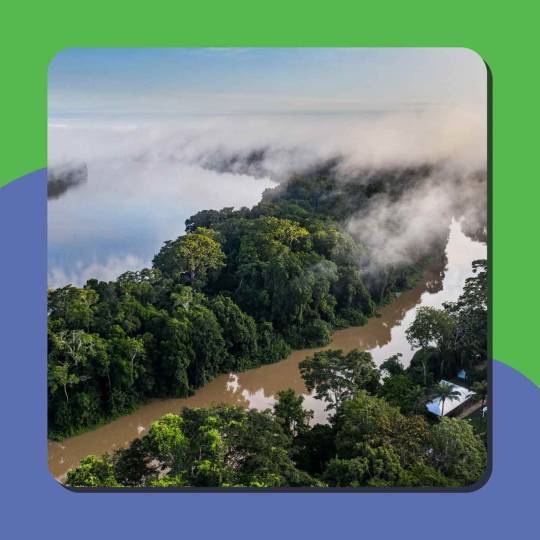
Pictured: Nouabalé-Ndoki National Park. Photo courtesy of Scott Ramsay/Wildlife Conservation Society
Evans credits the ongoing collaboration with this milestone, as the MEF and WCS have helped address escalating threats to wildlife in the region.
This specifically includes investments in the ranger force, which has increased training and self-defense capabilities, making the force more effective in upholding the law — and the rights of humans and animals.
“Thanks to the strengthening of our anti-poaching teams and new communication technologies, we have been able to reduce poaching considerably,” Max Mviri, a park warden for the Congolese government, said in a video for the Park’s anniversary.
“Today, we have more than 90 eco-guards, all of whom have received extensive training and undergo refresher courses,” Mviri continued. “What makes a difference is that 90% of our eco-guards come from villages close to the Park. This gives them extra motivation, as they are protecting their forest.”
As other threats such as logging and road infrastructure development impact the area’s wildlife, the Park’s partnerships with local communities and Indigenous populations in the neighboring villages of Bomassa and Makao are increasingly vital.
“We’ve seen great changes, great progress. We’ve seen the abundance of elephants, large mammals in the village,” Gabriel Mobolambi, chief of Bomassa village, said in the same video. “And also on our side, we benefit from conservation.”
Coinciding with the Park’s anniversary is the roll-out of a tourism-focused website, aiming to generate 15% of its revenue from visitors, which contributes significantly to the local economy...
Nouabalé-Ndoki also recently became the world’s first certified Gorilla Friendly National Park, ensuring best practices are in place for all gorilla-related operations, from tourism to research.
But gorillas and elephants — of which there are over 2,000 and 3,000, respectively — aren’t the only species visitors can admire in the 4,334-square-kilometer protected area.
The Park is also home to large populations of mammals such as chimpanzees and bongos, as well as a diverse range of reptiles, birds, and insects. For the flora fans, Nouabalé-Ndoki also boasts a century-old mahogany tree, and a massive forest of large-diameter trees.
Beyond the beauty of the Park, these tourism opportunities pave the way for major developments for local communities.
“The Park has created long-term jobs, which are rare in the region, and has brought substantial benefits to neighboring communities. Tourism is also emerging as a promising avenue for economic growth,” Mobolambi, the chief of Bomassa village, said in a press release.
The Park and its partners also work to provide education, health centers, agricultural opportunities, and access to clean water, as well, helping to create a safe environment for the people who share the land with these protected animals.
In fact, the Makao and Bomassa health centers receive up to 250 patients a month, and Nouabalé-Ndoki provides continuous access to primary education for nearly 300 students in neighboring villages.
It is this intersectional approach that maintains a mutual respect between humans and wildlife and encourages the investment in conservation programs, which lead to successes like 2023’s poaching-free milestone...
Evans, of the Park’s management, added in the anniversary video: “Thanks to the trust that has been built up between all those involved in conservation, we know that Nouabalé-Ndoki will remain a crucial refuge for wildlife for the generations to come.”"
-via Good Good Good, February 15, 2024
#conservation#congo#republic of congo#elephant#gorilla#endangered species#biodiversity#conservation news#conservation efforts#indigenous communities#national park#protected areas#poaching#elephant poaching#ecology#biology#environment#environmental news#forests
1K notes
·
View notes
Text

youtube
Excerpt from this story from the Daily Maverick:
Five mature elephant bulls have been shot by trophy hunters in Tanzania in the past eight months, at least two of which are said to have been “super-tuskers”. An unofficial agreement between Kenya and Tanzania had protected these elephants for 30 years. A new Avaaz petition rightly calls on the Tanzanian government to end the madness.
The Amboseli elephants have been studied extensively for nearly five decades now. Much of what we know about elephants is literally thanks to this set of remarkable elephant families.
The 30-year reprieve (and the fact that Kenya long ago banned trophy hunting) allowed the Amboseli population to thrive and produce some of the world’s most magnificent bull elephants despite the general population decimation trends across the continent. These trends only slowed after the US and China imposed domestic ivory trade bans in 2015 and 2017 respectively.
As renowned Amboseli elephant researcher Cynthia Moss told Africa Geographic, “shooting an Amboseli bull is about as sporting as shooting your neighbour’s poodle.”
It is unconscionably cruel to shoot highly habituated elephants for “sport”. As Moss, who is one of the leading Amboseli scientists, rightly points out, it is hardly “fair chase” or “ethical” to shoot an Amboseli bull with a high-calibre rifle.
Given how few big tuskers are left in the world (some estimates suggest fewer than 50), the agreement to leave the Amboseli population alone couldn’t be more important, not only for genetic heritage but for the sake of any future hope of human-elephant coexistence. Elephants are increasingly being born with smaller (or no) tusks in response to the rapacious history of poaching and trophy hunting for ivory over the past 200 years. Tuskless elephants have lost their essential “elephantness”.
In response to the recent killing, some of the world’s foremost elephant scientists penned a letter to Science, a leading academic journal, calling for authorities to end the trophy hunting of big-tusked elephants in northern Tanzania.
14 notes
·
View notes
Text
Dead Elephant Found in Baharagora Village Field
A female elephant was found dead in a field in Baharagora, suspected of heart attack. A female elephant was discovered dead in Baharagora’s Bhadua village on Friday morning, with veterinarians suspecting a heart attack. JAMSHEDPUR – On Friday morning, a female elephant was discovered dead in the field of farmer Dakhin Murmu in Bhadua village, Sandra Panchayat, Baharagora block. Upon receiving the…
#animal welfare#जनजीवन#Baharagora#Elephant Death#Elephant Poaching#Elephant Safety#Environmental News#forest department#Jamshedpur News#Kolhan#Life#wildlife conservation
0 notes
Text

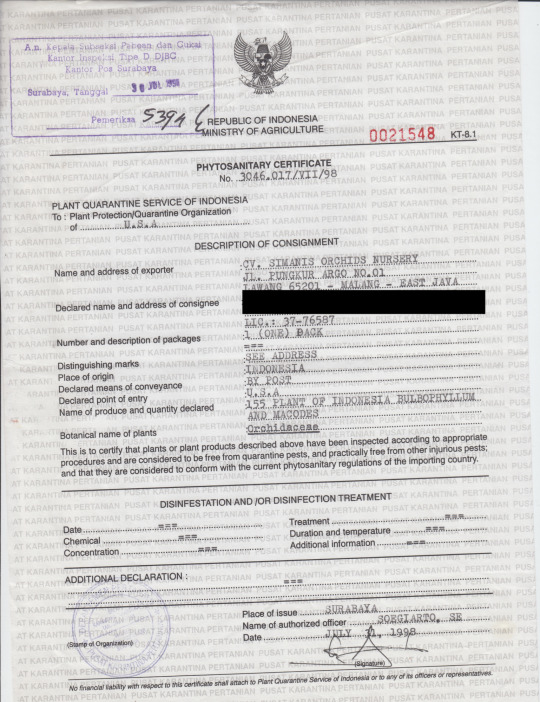





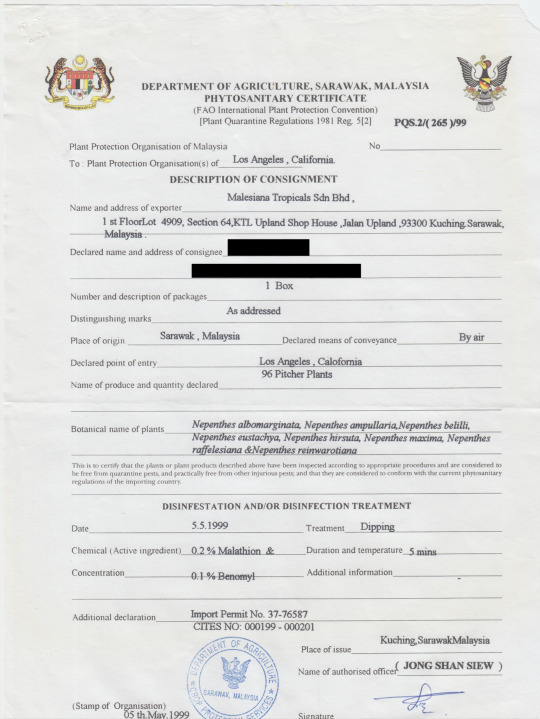
ok INCREDIBLY old content originally meant for this blog but in 2018 when i was just a wee lad with a little spinner propeller hat and big rainbow lollipop i went to a carnivorous plant convention in california and met a bunch of people who breed/collect/study these guys. one person was this collector who was slowly working on leaving the hobby or at least no longer growing plants, and he had a bunch of carnivorous plant related files he was charging like 50 cents for or something, and so i came into possession of these, which are examples of the kind of paperwork you have to have done to legally ship/trade endangered species of both plants and animals. functionally very boring paperwork, but something i found like, incredibly fascinating. i blacked out the personal id of the person and then immediately forgot to ever upload them, lmao.
these plants were bred and raised in a greenhouse and sold abroad, not taken from the wild, but because the species are endangered and often protected in their native countries (most of these are nepenthes, asian pitcher plants, a huge family spread throughout oceania and southeast asia), there's a lot more documentation that needs to be done regardless of their origin, both on the end of the seller and on the end of the buyer.
the rabbit hole on carnivorous plant trade is deep and kind of wild. there's plenty of common, non-threatened, greenhouse-grown pitcher plants on the market that people buy all the time, even non-collectors, but there's a whole debate to be had on if it's morally okay to be collecting the more endangered/rare of these plants in the first place. the big argument for breeding is that breeding them in captivity means there's more supply that's not poached from the wild, meaning poachers have less of an incentive to take the risk of taking adult plants from their habitats; from what i've heard, sometimes countries will issue permits for breeders to collect some wild seeds just to create a non-wild breeding pool to drive down the price. predictably, however, you also get people who are very much willing to pay a lot of money to get as rare of a plant as possible.
anyone familiar with the allure valuable plants have had over people throughout history can imagine the rest, but here's an article about a guy who started buying poached plants to enrich his private nepenthes collection, who then got busted by a fish and wildlife service agent embedded in his carvirorous plant circle. the plants this guy was buying were being sold to him without any CITES paperwork or declarations like the ones above; it was literally just a guy in indonesia taking rare plants from the woods around where he lived, selling them over facebook marketplace and ebay, and mailing them overseas as an undeclared 'gift' to get around customs. frighteningly small steps to take on all sides, to be honest.
(also, fun fact: another example of carnivorous plants that get poached are wild venus fly traps, which are only native to north and south carolina in the US. from what i understand it's a mix of people who genuinely did not know it's a native species and people who really are just going out into the woods and digging up plants to sell online. sometimes poaching is closer to home than you'd think!)
anyway. wild and interesting times in the land of plants recovered from a hard drive lmao
#nepenthes#annual 'plant poaching happens and it doesnt always look like the movies' post i suppose but also i think its really interesting#also the CITES system could do with an overhaul in how it approaches plants as well from what i understand but thats another thing#ive heard that like many systems like this they do not have the same urgency for plants as they do for animals#mostly because people just!! they dont get plants man!! they just say whatever its a plant!!#and poaching in general is only ever talked about like its with taking elephants for their tusks and stuff#also important conservation work but sometimes poaching really is just a guy with a shovel and that shit is WILD#carnivorous plants
525 notes
·
View notes
Text
As a helicopter hovers close to an elephant, trying to be as steady as possible, an experienced veterinarian cautiously takes aim. A tranquilizer dart whooshes in the air, and within minutes the giant mammal surrenders to a deep slumber as teams of wildlife experts rush to measure its vitals and ensure it’s doing ok. Kenya is suffering from a problem, albeit a good one: the elephant population in the 42-square-kilometer (16-square-mile) Mwea National Reserve, east of the capital Nairobi, has flourished from its maximum capacity of 50 to a whopping 156, overwhelming the ecosystem and requiring the relocation of about 100 of the largest land animals. It hosted 49 elephants in 1979. According to the Kenya Wildlife Service Director General Erustus Kanga, the overpopulation in Mwea highlighted the success of conservation effort s over the last three decades. “This shows that poaching has been low and the elephants have been able to thrive,” Kanga said. Experts started relocating 50 elephants last week to the expansive 780-square-kilometer (301-square-mile) Aberdare National Park in central Kenya. As of Monday, 44 elephants had been moved from Mwea to Aberdare, with six others scheduled for Tuesday.
156 notes
·
View notes
Text

#elephant#animalrights#econotego#poaching#poachers#africa#pollution#global warming#environmental activism#environmental#ausgov#politas#auspol#tasgov#taspol#australia#fuck neoliberals#neoliberal capitalism#anthony albanese#albanese government#class war#eat the rich#eat the fucking rich#anti donald trump#anti joe biden#anti capitalism#antinazi#anti colonialism#anti cop#anti colonization
40 notes
·
View notes
Text

Elephant herds used to be so much larger. Photo by Peter Beard.
#africa#elephants#kenya#herd#poaching#1970s#1970s history#migratory#south africa#landscape#nature#wildlife#damn humans#savannah#self awareness#elephant memory#endangered species#ivory trade#habitat destruction#bread and circuses#evolution#conservation#tanzania#nambia
11 notes
·
View notes
Text
youtube
Rangers vs Poachers: The Fight to Save Africa’s Elephants | Guardians | BBC Earth
23 May 2025
Once a poacher, now a protector – Modiki leads a fearless ranger team risking their lives to save Africa's endangered elephants in Dzanga-Sangha, one of the continent's last untouched wildernesses.
This powerful story of redemption and resilience reveals the brutal battle to save a vital ecosystem from poachers – and why protecting this wild Eden matters to us all.
His Royal Highness Prince William and The Royal Foundation's United for Wildlife programme bring you Guardians, a groundbreaking new docuseries available exclusively on BBC Earth.
Make sure to subscribe so you don’t miss an episode!
—
The series was co-produced with award winning studio ZANDLAND and each episode offers exclusive access, interviews and dynamic storytelling from rangers across the world.
The series follows the remarkable stories from:
• Central African Republic and the breathtaking Dzangha-Sangha protected area, following a reformed poacher who now dedicates his life to protecting the wildlife he once hunted.
• The Himalayas, India — where high in the Spiti Valley rangers are working to bring co-existence between the snow leopards known as ‘Ghosts of the Himalayas’, and local communities.
• Mexico’s Sea of Cortez once called ‘the world’s aquarium’ – and the story of a reformed illegal fisherman now working to protect this threatened ecosystem.
•Kruger National Park in South Africa — where teams work round the clock to protect, rescue and rehabilitate critically endangered rhinos which face daily poaching threats.
• Sri Lanka — where veterinary experts work tirelessly to rehabilitate elephants, leopards and other wildlife, while balancing patrolling duties and mitigating human-elephant conflicts.
• Caru Indigenous Land, Brazil — and the community-led fight to preserve their heritage and protect ancestral lands from environmental destruction.
#Youtube#united for wildlife#the royal foundation#Dzanga-Sangha#elephants#endangered animals#guardians#rangers#wildlife rangers#wildlife#save wildlife#protect wildlife#ecosystem#protect the rangers#ban poaching#stop poaching#bbc earth#prince william#prince of wales#british royal family#south africa#africa#african elephant#heroes#wilderness#save the earth#zandland
6 notes
·
View notes
Text
so worried about elephant care in khao kheow zoo, demonizing thai people taking care of their animals. Now wheres all the twitter threads, the tumblr posts about the flooding in thailand that affected the animals- calling for everyones support to care for these animals.
Elephants, not in KKZ, are dead because they werent trained with the OHH SO BAD TOOLS that saved OTHER elephants in nearby camps, they weren't used to people, they weren't used to the tools used. But yeah, SEA's animal husbandry is not up to par to western countrys husbandry.
You guys can type and theorize, conspire about all these bad things about how SEA or literally just how people outside of europe, outside of north america, outside of ENGLISH SPEAKING ONLINE SPACES.
So concerned about animals that you're not caring for, not knowing the first damn thing about what to do in emergencies like this.
I hope you all learn to stop making this dreaded posts calling for the pulling back support for these zoos. Assuming everything from videos, doing all you can to theorize- yet NOTHING comes up when people and animals are ACTUALLY suffering.
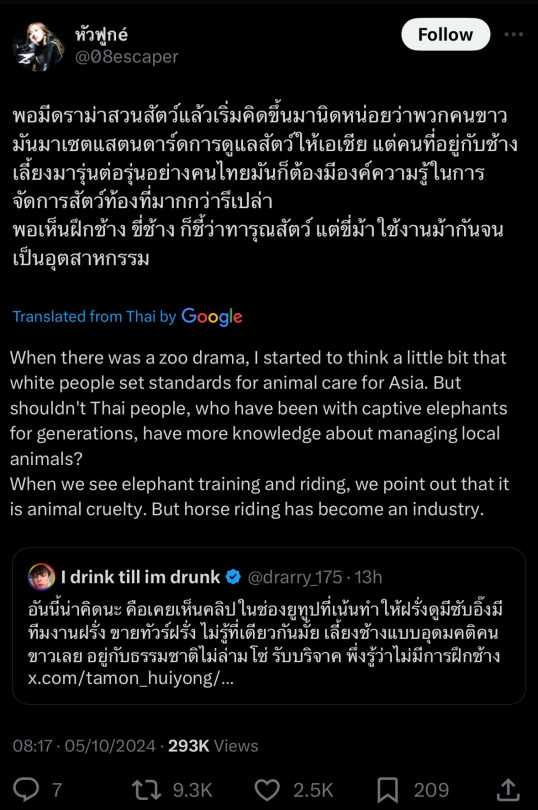
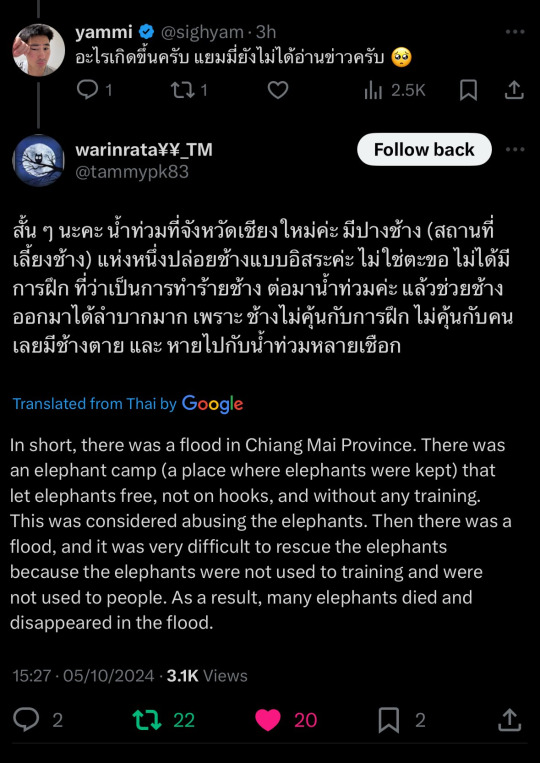


#so fucking angry#khao kheow open zoo#moo deng#elephants#nature#angry rant#animal abuse#wheres all the zoologists now?#wheres all the animal behaviourists?#how could they rescue them if not trained#“oh but there is poaching and bad zoos!”#and i didnt say there isnt
6 notes
·
View notes
Text
When the popular nature blogger says some poacher apologist shit

#sumatran tiger#asian elephant#giant pangolin#Visayan warty pig#amur leopard#poaching#not a rb#conservation#endangered animals
3 notes
·
View notes
Text

2 notes
·
View notes
Photo

Finding a motive: The researchers looked at more than 10,000 elephant killings across 30 countries in Africa. Now their data proves a longtime theory: Poaching is driven by need rather than greed. “When we are looking to protect wildlife, we can't do that without thinking about the well-being of people,” Timothy Kuiper, a co-author of the study, tells us. (Pictured above, an African elephant grazes in a field in a reserve in Kenya.)
PHOTOGRAPH BY DAVID CHANCELLOR, NAT GEO IMAGE COLLECTION
#david chancellor#photographer#national geographic#elephant#mammal#animal#wildlife#poaching#african elephant#kenya#animal reserve#nature
18 notes
·
View notes
Text
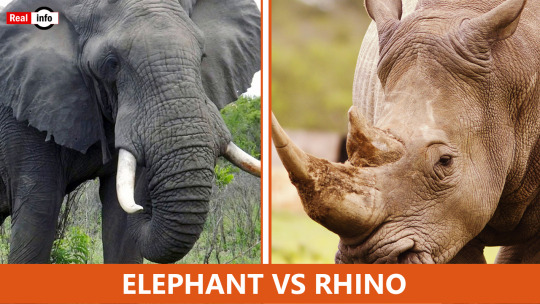
#Indianelephant, #rhinoceros #Horn #Wildlifetrafficking #BigFive #Savannah #TuskProtection #Nationalparks #Wildlifereserves #Biodiversity #Africanwildlife #Asianwildlife #Wildlife #sanctuaries #Elephant #calves #Rhinocalves #Wildlifepoachers #Conservation #efforts #Wildliferehabilitation #Antipoaching #measures #AnimalRights #Wildlifedocumentaries #Wildlifephotography, #Elephantbehavior #rhinobehavior #Conservation #organizations #Wildlifetracking #Wildliferangers #Wildlifeeducation #Ecotourism #Conservationbiology #Wildlifehabitats #Elephant #intelligence #Rhinointelligence #Wildlifeextinction #Wildlife protection #lawsAnimal #welfare #Wildliferesearch #Wildlife migration #Wildlife #populationtrends
A matchup between an elephant and a rhinoceros would be quite the spectacle! Both are massive animals with unique features and strengths.
In terms of sheer size, African elephants are the largest land animals, weighing several tons and standing up to 13 feet tall at the shoulder. Rhinoceroses, on the other hand, are smaller but still formidable, with the largest species, the white rhinoceros, weighing around 2.2 to 3.6 tons.
In a confrontation, the outcome would likely depend on various factors such as the species of elephant (African vs. Asian), the species of rhinoceros (white, black, Indian, etc.), the individuals involved, and the circumstances of the encounter.
Elephants are known for their intelligence, social structure, and formidable strength. Their tusks can be used as weapons, and they have powerful trunks that can push over trees and fend off predators.
Rhinoceroses, while not as agile or intelligent as elephants, possess thick, armor-like skin and formidable horns. Their charge can be incredibly powerful, and they have been known to flip vehicles in confrontations.
youtube
#Elephant#Rhino#Wildlife#Conservation#Safari#Endangered species#Ivory#Poaching#Habitatloss#Africanelephant#Indian elephant#rhinoceros#Horn#Wildlifetrafficking#BigFive#Savannah#TuskProtection#Nationalparks#Wildlifereserves#Biodiversity#Africanwildlife#Asianwildlife#sanctuaries#calves#Rhinocalves#Wildlifepoachers#efforts#Wildliferehabilitation#Antipoaching#measures
2 notes
·
View notes
Text

6 notes
·
View notes
Text
Discover why African elephants are vanishing at an alarming rate, the threats they face, and what can be done to protect these majestic giants from extinction.
#African elephants#elephant extinction#wildlife conservation#ivory poaching#endangered species#protect elephants#African wildlife#TheJuniorAge#KidsNewspaper#Newspaper For Children#KidsNewspaperIndia
0 notes
Text
If ever an image went hard as fuck...

Kenyan soldier standing in front of a pile of ivory prior to burning.
221 notes
·
View notes